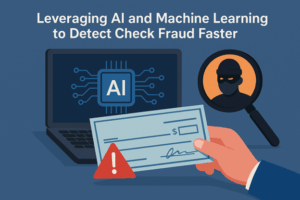Leveraging AI and Machine Learning to Detect Check Fraud Faster

Fraud is one of the biggest challenges facing community banks and credit unions today. According to the U.S. Department of the Treasury, check fraud has increased by nearly 385% since 2020, making it the payment method most targeted by criminals. At the same time, financial institutions are under pressure to protect customers, comply with regulatory requirements and maintain trust, all while managing limited resources.
The good news is technology is catching up with these threats. Artificial Intelligence (AI) and Machine Learning (ML) are changing how banks detect and prevent fraud, so they can spot suspicious activity in real time rather than hours or days after losses occur. This article explains how these technologies work, why they’re needed to fight check fraud and what financial institutions should consider when implementing them.
Understanding Check Fraud in the Digital Age
Check fraud is when someone illegally manipulates or uses checks to get money or valuable goods through deception. This includes writing checks from accounts with insufficient funds, forging signatures, altering amounts or creating counterfeit checks. Although check usage is declining, criminals are still targeting checks because they contain sensitive information, account numbers, routing numbers, and signatures that can be used for various fraud schemes.
Plus, checks are still a preferred payment method for many businesses, with 91% of organizations surveyed saying they still use checks and over 75% saying they have no plans to stop using them. This widespread usage makes checks a lucrative target for fraudsters, as seen in the Association for Financial Professionals 2025 survey which found checks to be the payment method most vulnerable to fraud, with 63% of respondents experiencing attempted or actual check fraud in 2024.
Types of check fraud today
Here are some common types of check fraud today:
- Counterfeit checks: Fraudsters create fake checks using advanced printing technology and computer software that looks like the real thing
- Altered checks: Criminals chemically “wash” or physically alter legitimate checks to change payee names or amounts
- Forged checks: Perpetrators steal blank checks and forge signatures to make unauthorized transactions
- Check kiting: Fraudsters exploit the “float” time between when checks are deposited and cleared
The sophistication of these schemes has increased, with criminals now using AI-powered tools to enhance their techniques, so they can create convincing check designs and even simulate handwriting.
Why traditional methods fall short
Most legacy fraud systems are rule-based. For example, they flag transactions that exceed certain dollar amounts or come from unusual locations. While these rules catch some fraud, they miss the subtle and increasingly complex patterns of today’s schemes.
Traditional systems also operate in batch mode, identifying fraud hours or even days after it happens. By then, funds are already gone. For check fraud, which often involves small but frequent amounts, these systems struggle to differentiate fraudulent activity from legitimate transactions.
So financial institutions are turning to advanced technologies like machine learning fraud detection and artificial intelligence fraud detection systems that can provide adaptive learning to combat these evolving threats.
How AI and Machine Learning Detect Check Fraud
Advanced artificial intelligence and machine learning technologies have revolutionized check fraud detection through advanced analysis methods that traditional systems can’t match. These technologies work through several complementary approaches to detect fraud faster and more accurately.
Pattern recognition in transaction data
AI excels at finding complex patterns by analyzing multiple variables at once. Unlike rule-based systems, machine learning models look at transaction history, user behavior and contextual information to find subtle correlations that would be invisible to human analysts. These models can process billions of records to find patterns across huge datasets, tracking and catching even the most complex frauds.
Behavioral biometrics and user profiling
Behavioral biometrics verifies user identity by continuously tracking distinctive behaviors like typing patterns, mouse movements and touchscreen interactions. These systems create unique behavioral profiles that are digital fingerprints, so users can be authenticated in the background. Plus, any deviation from established patterns, like unusual typing speed or irregular touchpad movement, can trigger immediate security measures.
Real-time anomaly detection
Modern AI systems have moved beyond batch processing to real-time analysis. This allows organizations to detect and respond to threats in real-time, not hours or days later. Essentially, machine learning models can establish a baseline of normal activity and flag transactions that deviate from expected patterns.
Adaptive learning from new fraud patterns
Perhaps the biggest advantage of AI-based systems is their ability to learn and evolve. As new fraud patterns emerge, these systems automatically incorporate them into their algorithms. This adaptive learning ensures fraud detection remains effective as criminal tactics get more sophisticated.
Types of Machine Learning Models
Machine learning uses three approaches to detect check fraud, each serving a purpose in the fraud prevention ecosystem.
1) Supervised learning for known fraud patterns
Supervised learning models train on labeled datasets of both fraudulent and legitimate transactions. These methods excel at classifying transactions based on previously identified fraud patterns. Random Forest with Random Oversampling achieves an F1-Score of 91.554%, making it one of the best algorithms for check fraud detection.
Other powerful supervised models include XGBoost (achieving the highest F1-Score of 92.43% with Random Oversampling), Logistic Regression, and Decision Trees. Financial institutions typically apply these models to identify familiar fraud schemes through classification of transaction data.
2) Unsupervised learning for unknown threats
Unsupervised learning addresses an important gap by detecting previously unseen fraud patterns without labeled data. These algorithms identify anomalies that deviate from normal transaction patterns.
Techniques like clustering, isolation forests, and autoencoders are good at flagging suspicious activity without prior examples. Unsupervised methods are particularly valuable for detecting evolving fraud tactics that supervised models might miss, especially when fraudsters adapt their strategies to evade detection.
3) Reinforcement learning for evolving strategies
Reinforcement learning is the latest fraud detection technology. Unlike traditional approaches, RL allows systems to learn optimal policies through continuous interaction with their environment. This adaptive capability allows fraud detection systems to adjust their strategies in response to emerging patterns.
By formulating fraud detection as a Markov Decision Process with states, actions and rewards, these models can optimize detection thresholds and feature importance weights in real-time, addressing the limitations of static models in responding to evolving fraud tactics.
Things to Consider When Implementing AI Fraud Detection
Implementing AI-driven fraud detection requires more than just choosing advanced algorithms. Financial institutions must consider several key factors to maximize fraud prevention while maintaining operational efficiency.
Choosing the right fraud detection platform
When selecting a fraud detection platform, organizations should start by assessing their specific fraud vulnerabilities and needs. The right solution should have real-time detection, scalability to handle increasing transaction volumes and seamless API integration with existing systems. Customizable risk assessment is also crucial so institutions can set specific rules aligned to their business requirements. According to IBM, AI fraud detection systems require significant upfront investment but save money through reduced fraud losses.
Explainability and transparency
Explainable AI (XAI) is now essential as regulatory bodies demand transparent decision-making processes. These techniques help fraud investigators understand why specific transactions were flagged as suspicious. Methods like SHAP (SHapley Additive Explanations) and LIME (Local Interpretable Model-agnostic Explanations) uncover decision-making processes in machine learning models. Organizations must maintain thorough documentation on how their AI models make decisions, which is particularly important for high-risk AI systems under regulations like the European AI Act.
Integration with existing banking systems
Successful implementation requires cross-functional fraud management teams that bring together IT, data science, customer service and operations expertise. This collaborative approach ensures fraud prevention aligns with business objectives and integrates with existing infrastructure. Throughout the integration process, institutions must plan for ongoing monitoring and system updates to stay effective against evolving threats.
Scalability and data privacy compliance
Finally, organizations must balance robust fraud detection with data privacy requirements. AI systems processing vast customer data must comply with regulations like GDPR and CCPA. Privacy-preserving techniques like homomorphic encryption and differential privacy can maintain compliance without compromising detection effectiveness. Regular privacy impact assessments also ensure fraud detection practices are ethical and legally compliant.
Conclusion
Check fraud is far from a relic of the past. It’s a growing and evolving threat. Criminals are using technology to make their schemes more convincing, more complex and more damaging. Traditional detection tools can’t keep up. AI and machine learning give financial institutions the tools to detect fraud faster, adapt to new tactics, reduce false positives, and protect customer trust.
Community banks and credit unions may think investing in AI fraud detection is a big ask. But as fraud losses rise and regulations increase, it’s a must. At SQN Banking Systems, we want to make sure all institutions have access to fraud protection solutions that fit their needs. By going AI fraud detection now, banks can protect their profits, their reputation and most importantly their customers.
